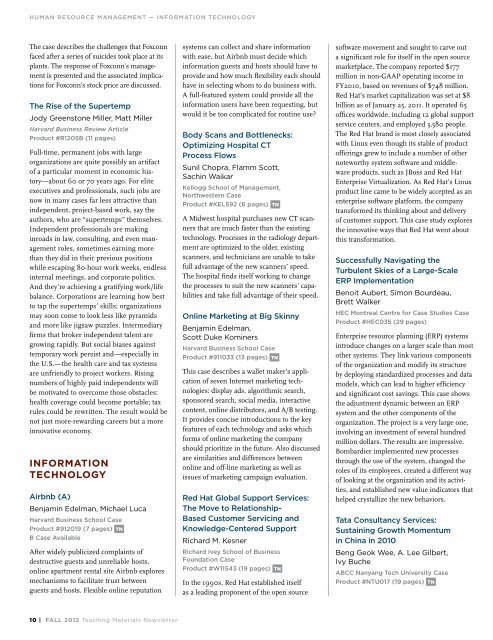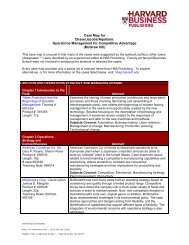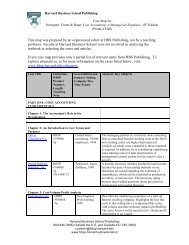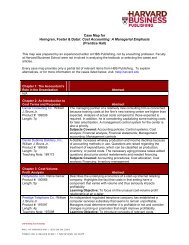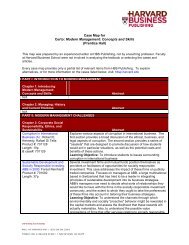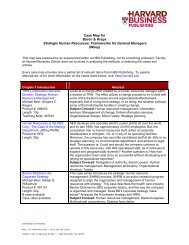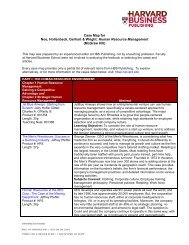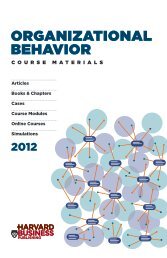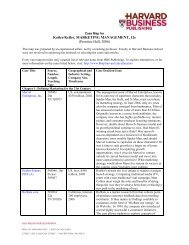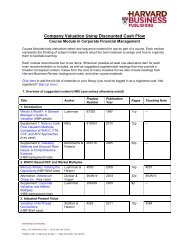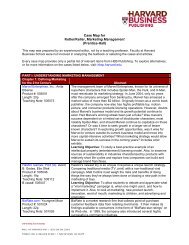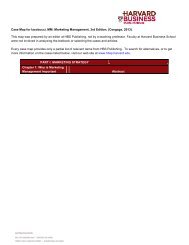teAcHing MATErIAlS - Harvard Business School Press
teAcHing MATErIAlS - Harvard Business School Press
teAcHing MATErIAlS - Harvard Business School Press
Create successful ePaper yourself
Turn your PDF publications into a flip-book with our unique Google optimized e-Paper software.
HUMAN RESOURCE MANAGEMENT — INFORMATION TECHNOLOGY<br />
The case describes the challenges that Foxconn<br />
faced after a series of suicides took place at its<br />
plants. The response of Foxconn’s management<br />
is presented and the associated implications<br />
for Foxconn’s stock price are discussed.<br />
The Rise of the Supertemp<br />
Jody Greenstone Miller, Matt Miller<br />
<strong>Harvard</strong> <strong>Business</strong> Review Article<br />
Product #R1205B (11 pages)<br />
Full-time, permanent jobs with large<br />
organizations are quite possibly an artifact<br />
of a particular moment in economic history—about<br />
60 or 70 years ago. For elite<br />
executives and professionals, such jobs are<br />
now in many cases far less attractive than<br />
independent, project-based work, say the<br />
authors, who are “supertemps” themselves.<br />
Independent professionals are making<br />
inroads in law, consulting, and even management<br />
roles, sometimes earning more<br />
than they did in their previous positions<br />
while escaping 80-hour work weeks, endless<br />
internal meetings, and corporate politics.<br />
And they’re achieving a gratifying work/life<br />
balance. Corporations are learning how best<br />
to tap the supertemps’ skills; organizations<br />
may soon come to look less like pyramids<br />
and more like jigsaw puzzles. Intermediary<br />
firms that broker independent talent are<br />
growing rapidly. But social biases against<br />
temporary work persist and—especially in<br />
the U.S.—the health care and tax systems<br />
are unfriendly to project workers. Rising<br />
numbers of highly paid independents will<br />
be motivated to overcome those obstacles:<br />
health coverage could become portable; tax<br />
rules could be rewritten. The result would be<br />
not just more-rewarding careers but a more<br />
innovative economy.<br />
informAtion<br />
tecHnology<br />
Airbnb (A)<br />
Benjamin Edelman, Michael Luca<br />
<strong>Harvard</strong> <strong>Business</strong> <strong>School</strong> Case<br />
Product #912019 (7 pages) tn<br />
B Case Available<br />
After widely publicized complaints of<br />
destructive guests and unreliable hosts,<br />
online apartment rental site Airbnb explores<br />
mechanisms to facilitate trust between<br />
guests and hosts. Flexible online reputation<br />
10 | fAll 2012 Teaching Materials Newsletter<br />
systems can collect and share information<br />
with ease, but Airbnb must decide which<br />
information guests and hosts should have to<br />
provide and how much flexibility each should<br />
have in selecting whom to do business with.<br />
A full-featured system could provide all the<br />
information users have been requesting, but<br />
would it be too complicated for routine use?<br />
Body Scans and Bottlenecks:<br />
Optimizing Hospital CT<br />
Process Flows<br />
Sunil Chopra, Flamm Scott,<br />
Sachin Waikar<br />
Kellogg <strong>School</strong> of Management,<br />
Northwestern Case<br />
Product #KEL592 (6 pages) tn<br />
A Midwest hospital purchases new CT scanners<br />
that are much faster than the existing<br />
technology. Processes in the radiology department<br />
are optimized to the older, existing<br />
scanners, and technicians are unable to take<br />
full advantage of the new scanners’ speed.<br />
The hospital finds itself working to change<br />
the processes to suit the new scanners’ capabilities<br />
and take full advantage of their speed.<br />
Online Marketing at Big Skinny<br />
Benjamin Edelman,<br />
Scott Duke Kominers<br />
<strong>Harvard</strong> <strong>Business</strong> <strong>School</strong> Case<br />
Product #911033 (13 pages) tn<br />
This case describes a wallet maker’s application<br />
of seven Internet marketing technologies:<br />
display ads, algorithmic search,<br />
sponsored search, social media, interactive<br />
content, online distributors, and A/B testing.<br />
It provides concise introductions to the key<br />
features of each technology and asks which<br />
forms of online marketing the company<br />
should prioritize in the future. Also discussed<br />
are similarities and differences between<br />
online and off-line marketing as well as<br />
issues of marketing campaign evaluation.<br />
Red Hat Global Support Services:<br />
The Move to Relationship-<br />
Based Customer Servicing and<br />
Knowledge-Centered Support<br />
Richard M. Kesner<br />
Richard Ivey <strong>School</strong> of <strong>Business</strong><br />
Foundation Case<br />
Product #W11543 (19 pages) tn<br />
In the 1990s, Red Hat established itself<br />
as a leading proponent of the open source<br />
software movement and sought to carve out<br />
a significant role for itself in the open source<br />
marketplace. The company reported $177<br />
million in non-GAAP operating income in<br />
FY2010, based on revenues of $748 million.<br />
Red Hat’s market capitalization was set at $8<br />
billion as of January 25, 2011. It operated 65<br />
offices worldwide, including 12 global support<br />
service centers, and employed 3,580 people.<br />
The Red Hat brand is most closely associated<br />
with Linux even though its stable of product<br />
offerings grew to include a number of other<br />
noteworthy system software and middleware<br />
products, such as JBoss and Red Hat<br />
Enterprise Virtualization. As Red Hat’s Linux<br />
product line came to be widely accepted as an<br />
enterprise software platform, the company<br />
transformed its thinking about and delivery<br />
of customer support. This case study explores<br />
the innovative ways that Red Hat went about<br />
this transformation.<br />
Successfully Navigating the<br />
Turbulent Skies of a Large-Scale<br />
ERP Implementation<br />
Benoit Aubert, Simon Bourdeau,<br />
Brett Walker<br />
HEC Montreal Centre for Case Studies Case<br />
Product #HEC035 (29 pages)<br />
Enterprise resource planning (ERP) systems<br />
introduce changes on a larger scale than most<br />
other systems. They link various components<br />
of the organization and modify its structure<br />
by deploying standardized processes and data<br />
models, which can lead to higher efficiency<br />
and significant cost savings. This case shows<br />
the adjustment dynamic between an ERP<br />
system and the other components of the<br />
organization. The project is a very large one,<br />
involving an investment of several hundred<br />
million dollars. The results are impressive.<br />
Bombardier implemented new processes<br />
through the use of the system, changed the<br />
roles of its employees, created a different way<br />
of looking at the organization and its activities,<br />
and established new value indicators that<br />
helped crystallize the new behaviors.<br />
Tata Consultancy Services:<br />
Sustaining Growth Momentum<br />
in China in 2010<br />
Beng Geok Wee, A. Lee Gilbert,<br />
ivy Buche<br />
ABCC Nanyang Tech University Case<br />
Product #NTU017 (19 pages) tn


